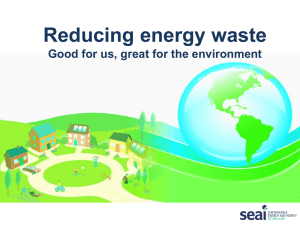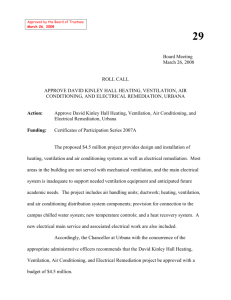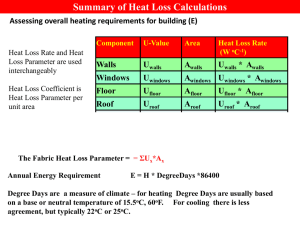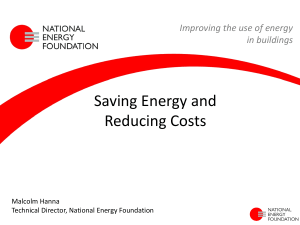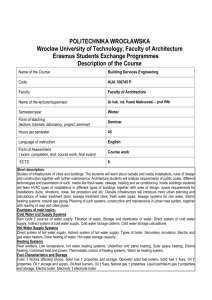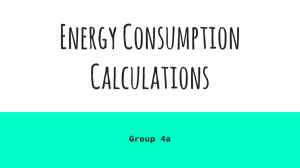Ove Morck, Cenergia
advertisement
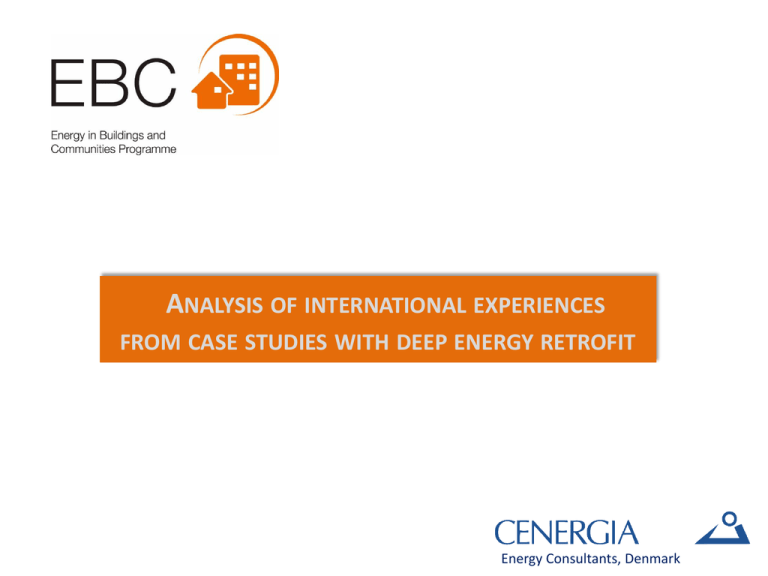
ANALYSIS OF INTERNATIONAL EXPERIENCES FROM CASE STUDIES WITH DEEP ENERGY RETROFIT Energy Consultants, Denmark SCOPE OF THE WORK 1. To show successful renovation projects as inspirations in order to motivate decision makers and stimulate the market. 2. To support decision makers and experts with profound information for their future decisions. 3. To learn from these forerunner project by analysing the presented information. CONTENTS OF THE PRESENTATION 1. Overview of the case studies 2. THE ANALYSES CARRIED OUT: • Energy saving strategies (which are climate dependent?) • Energy savings/reduction • Reasons for renovation/anyway measures • Co-benefits • Business models and funding sources • Cost effectiveness • Experiences/lessons learned 3. Recommendation 2 CASE STUDIES COUNTRY SITE BUILDING TYPE 1.Austria Kapfenberg Social housing 2.Germany Ludwigshafen-Mundenheim Multi-stories apartment 3.Germany Nürnberg, Bavaria Multi-stories apartment 4.Germany Ostfildern Gymnasium 5.Germany Baden-Württemberg School 6.Germany Osnabrueck School 7.Germany Olbersdorf School PICTURES 3 CASE STUDIES COUNTRY SITE BUILDING TYPE 8.Germany Darmstadt Office building 9.Denmark Egedal, Copenhagen School 10.USA Grand Junction, Colorado Office Building / Courthouse 11. USA Silver Spring and Lanham, Maryland Federal Building/ Office 12. USA St. Croix. Virgin Islands Office/Courthouse 13. Estonia Kindergarten in Valga Kindergarten 14. Latvia Riga Multi-family building PICTURES 4 Analyses undertaken • Energy saving strategies (which are climate dependent?) • Energy savings/reduction • Reasons for renovation/anyway measures • Co-benefits • Business models and funding sources • Cost effectiveness • Experiences/lessons learned 5 W al li n Ro sula tio of n in Flo sul at or io in n s ul Ne at w i Ro win on of do Ef ligh w/ fic ts do ie or Da ncy yl li M igh ght VH t s in g t Ne R art /co e w gy ntr /e ol Ne ven xt w til er na Ne hea atio ls w t-c n s ha y o h Gr ea ol st di ng ou t s ing em So nd up su la co ply pp r Ph the upl :rad lier ot rm ed ia /di BE ovo al hea tor, stri M l t a s y t p fl o b u S ic ste um or tio pa m p hea n sy ne tin st ls g. e m . ENERGY SAVING STRATEGIES 1.Johann Böhmstrasse Austria 2.PHI.GAG.Hoheloog.Ludwigshafen. GE 3. Nurnberg.GE 4.Gym Ostildern. GE 5.School BaWû. GE 6.Angela School. Osnabrueck.GE 7.Friedrich-Fröbel-Schule Olbersdorf. GE 8.Office Passive house. Darmstadt.GE 9.Stengårds school.DK 10.USA. Colorado 11.USA. Maryland 12.USA. St. Croix 13. Estonia 14.Latvia >8 √ √ √ √ √ √ √ √ √ √ √ √ √ √ √ √ √ √ √ √ √ √ √ √ √ √ √ √ √ √ √ √ √ √ √ √ √ √ √ √ √ √ √ √ √ √ √ √ √ √ √ √ √ √ √ √ √ √ √ √ √ √ √ √ √ √ √ √ √ √ √ √ √ √ √ √ √ √ √ √ √ √ √ √ √ √ √ √ √ √ √ √ √ √ √ √ √ √ √ √ √ √ √ √ √ √ √ √ 6 % ENERGY REDUCTION CASE STUDY % Energy reduction Heat pump PV production Solar thermal 14 kWh/m2 Heating 74.8 Electricity x 92kWp 2.PHI.GAG.Hoheloog.Ludwigshafen.GE 94 0 12.8 kWp 3.Nurnberg. GE 86 0 4.Gym Ostildern.GE 51 2 5.School BaWû.GE 70 x 6.Angela School. Osnabrueck.GE 96 17 45.6kwh/m2 7. Friedrich-Fröbel-Schule Olbersdorf. GE 67 54 x 8.Office Passive house retrofit. Darmstadt.GE 78 70 9.Stengårds school.DK 34 22 x 220kwp 100 (gas) 19 x x x x 1.Johann Böhmstrasse. Austria 10.USA. Colorado 11.USA. Silver Spring and Lanham/Maryland 47/61 12.USA. St. Croix 13.Estonia 14. Latvia X: missing data 100 87 x 28,7 KWp x x x 54 7 Energy before and after - comparison plot 8 Energy before and after - comparison plot 9 ANYWAY MEASURES/ REASON FOR RENOVATION ENERGY RELATED REASON High energy consumption leads to high energy cost. Fluctuation in annual cost NON ENERGY RELATED REASON Poor appearance of the building due to the deterioration of the construction element of the building envelope. Poor thermal comfort / Overheating Historic preservation. Air polluted. No indoor quality comfort Unsatisfied technical condition of building envelope Building does not comply with renewable energy goals Deterioration of the interior finishing of the building Research on energy efficiency in buildings Poor architectural quality Insufficient daylight Change of layout of the occupied space needed / Out-dated working environment Out-dated technical facilities The mechanical systems, plumbing, electrical, roofing, and elevators had long surpassed their useful life. High-maintenance technology – costly to maintain Condensation in external walls Out-dated equipment Air leaks - primarily in windows and a top-floor ceiling Poor acoustic quality 10 CO-BENEFIT CO-BENEFIT FROM ENERGY RELATED MEASURES Annual energy use reduction. BENEFIT FROM NON-ENERGY RELATED MEASURES Historical preservation Improved indoor environmental quality by installed MVHR Architectural attraction by a modern facade. Environmental friendly construction improving the reputation of the building Reduction of pollution by new exhaust air system. New functional area for the occupants Improvement of thermal comfort by tightness of the building Reduction of heating energy by the connection to the district heating. Renewal of old heating and DHW system improve the operational comfort by the new centralized and automatically control system. Creates/sustains jobs. New plan design in the useful area. Increased living space Provide a pleasant, secure, and safe environment Better connection into/ to the building Improved operational comfort by automatically controlled Reduced energy costs for tenants/ Higher rent costs. lighting and ventilation system. Energy demand reduction through insulation combined with Reduced ongoing maintenance heat pump. Use of sustainable construction practices. Upgrade equipment Daylight improvement. Improvement of the acoustics Reduces tons of CO2. Environmental contribution Protect the building from the weatherization Reduction of draughts by implementation of thermal glazing Promotes overall energy awareness BUSINESS MODELS AND FUNDING SOURCES CASE STUDIES BUSINESS MODELS AND FUNDING SOURCES 1.Johann Böhmstrasse Austria • Standard monthly “Maintenance and improvement contribution” by the tenantsfunding model: For “Comprehensive energetic renovation” (requirements) • Subsidy for: “implementation of ecological and sustainable measures” • Subsidized feed-in tariff for electricity generated by PV • Subsidy loans for social housing companies – 0.5 % - 25 years • Austrian research program “Building of Tomorrow” supported 35% of the innovative cost (cost difference to standard renovation) 3. Nurnberg.GE • Funding by the Bavarian Ministry of Economics in connection with the EU-Objective-2 program. 4.Gym Ostildern • Self-financing • With KfW-credit: financing-part of energetic refurbishment measures: 47 % 5.School BaWû • Self-financing • Stimulus package II, bank loan + self-financing, Heating through EPC. Owner and federal ministry for environment Federal ministry for environment through the funding program “Energie optimiertes Bauen and EnEff:Schule” 6.Angela School. Osnabrueck.GE 7. Friedrich-Fröbel-Schule Olbersdorf. GE 8.Office Passive house retrofit 9.Stengårds school.DK 10.USA. Colorado 12. USA. St. Croix 13.Estonia 14. Latvia The retrofit financed by the building owner Loan at low interest rates for Danish municipalities • American Recovery and Reinvestment Act of 2009 • Agency provided funds (RWA) • ARRA funding time-frame for completion. • The ESPC funding model is based on 3rd party • EU supported Project • Local government fund • RENESCO, EU grants (European Reconstruction and Development fund) • Loans: Citadele Bank - commercial loan; • Dutch International Guaranties for Housing (DIGH) - subordinated loan COST EFFECTIVENESS CASE STUDIES 1.Johann Böhmstrasse Austria COST EFFECTIVENESS - Simple pay-back time Energy related investment costs € 1.245.201,000 Energy savings per year - electricitity € 13.911,000 Energy savings per year - district heating € 25.734,000 Energy Savings per year - total € 39.645,000 Simple pay-back time 31 years - Dynamic investment method Results stated below are based on following assumptions: Inflation rate per year: 2,2% Interest rate: 3,75% Interest rate inflation-adjusted: 1,52% Price rise for electricity per year: 3% Price rise for electricity per year inflation-adjusted: 0,78% Price rise for district heating per year: 3% Price rise for district heat. per year inflation-adjusted 0,78% • Internal interest rate: 1,52% per year • Cash value: € 254.362 • Annuity method Annuity: € 14.266.- per year for 30 years Annuity factor: 0,05 • Dynamic amortization period 26 years - Investment costs of energy saved: For an operation period of 30 years of most important measures are stated (without maintenance and replacement costs): • Reduction of transmission losses € 0,08 /kWh • Reduction of ventilation losses (MVHR) € 0,25 / kWh • Reduction through solar thermal panels € 0,05 / kWh • Reduction through PV panels € 0,10 / kWh - Life cycle cost assessment (LCCA) COST EFFECTIVENESS CASE STUDIES 6.Angela School.GE COST EFFECTIVENESS • Interest rate: 3.43% (government bond) • Present value: Investment costs Building measures Technical measures without ventilation Ventilation Sum investment costs Maintenance costs Heat pump and building automation Ventilation and heat recovery Sum maintenance costs 9..Stengårds school.DK Economical saving Net heating saving: Electricity saving: Total saving: Total energy investment: Simple payback time: - 303 k€ - 279 k€ - 600 k€ - 1.182 k€ Energy costs reduction Gas (and vegetable oil) Electricity without ventilation Electricity for ventilation Sum energy costs reduction Water Total 663 k€ 0,1 k€ - 42 k€ 621 k€ - 13 k€ - 752 k€ - 59 k€ - 119 k€ - 178 k€ 358.849 kWh 603.418 kWh 43.351 Euro/year 178.191 Euro/year 221.541 Euro/year 2.437.452 Euros 11 years 14 EXPERIENCES/ LESSONS LEARNT ENERGY Mainly the energy for heating is halved by the refurbishment of the building envelope Threefold reduction of the heating energy by the new connection to district heating. Energy reduction by approximately 80% through insulation combined with heat pump. The improvement of all specific technologies contributes in reducing energy consumption for heating and cooling. Electricity consumption can be reduced through passive solar building design and/or solar technologies. Energy should also be reduced by means of demand side measures. Energy exchange between buildings with different user/load profiles offer potential for further energy reduction. Plus-energy standard for multi-story buildings can been achieved High heat demand due to the fact of the decreasing of the HR ventilation efficiency Refurbishment with passive house components leads a reduction up to factor 10 of the former heating demand. It is always more challenging to implement new and innovative technologies and solutions in existing buildings comparing to new buildings. Reduction of electricity production from oil, leads to a reduction of CO2, significant in an island environment . EXPERIENCES/ LESSONS LEARNT USE AND COMFORT Significant improvement of the indoor air quality through ventilation system. The indoor air quality increased strongly, a more stable humidity and a lot less pollution was achieved. The building systems provide a high level of temperature controllability (with a digital thermostat). Space utilization changes: new ground floor design. New layout of the occupied space was integrated in the planning process from the beginning. Too dry air from high ventilation rates Negative aspects in the light shading due to automatic jalousie A VOC sensor has to be installed in some classroom to reduce the exceed CO2 EXPERIENCES/ LESSONS LEARNT USER BEHAVIOUR The human behaviour play a key role in the energy consumption. Occupants behaviour must be documented. Heating consumption is higher than calculated due to user behaviour and, higher looses. The energy consumption& Indoor comfort decreased significantly by user training programs and improved documentation for common IT control equipment. The positive aspects lead to the fact that more users are aware of energy saving. EXPERIENCES/ LESSONS LEARNT RECOMMENDATIONS Decisions made in early project stages have strong influence on energy performance and costs. The planning for heating system, ventilation, sun protection and lighting showed the potential for optimization Projects pursuing net zero energy should consider these 3 stages: Stage 1 – occupant engagement for energy use, including IT representatives Stage 2 – Investment of deep energy retrofit Stage 3 – After 1-year of post occupancy install renewable resources to offset tracked energy demand. Innovative business models for Deep Energy Retrofit have to be developed. Use of an ESPC business/funding model for rapid implementation of the project Further development of high efficient energy retrofit will be the most economical standard to refurbish buildings Thank you for your attention! Questions?
